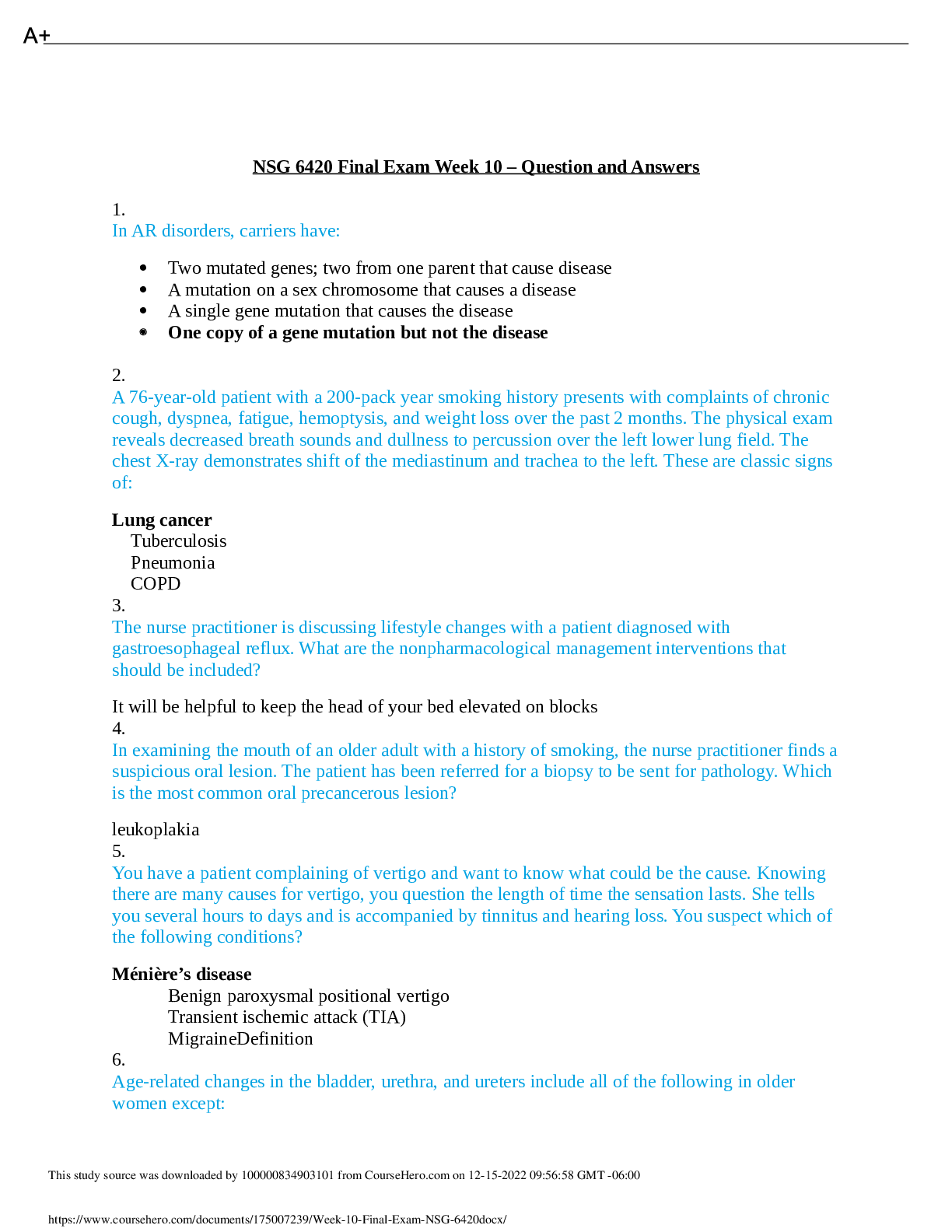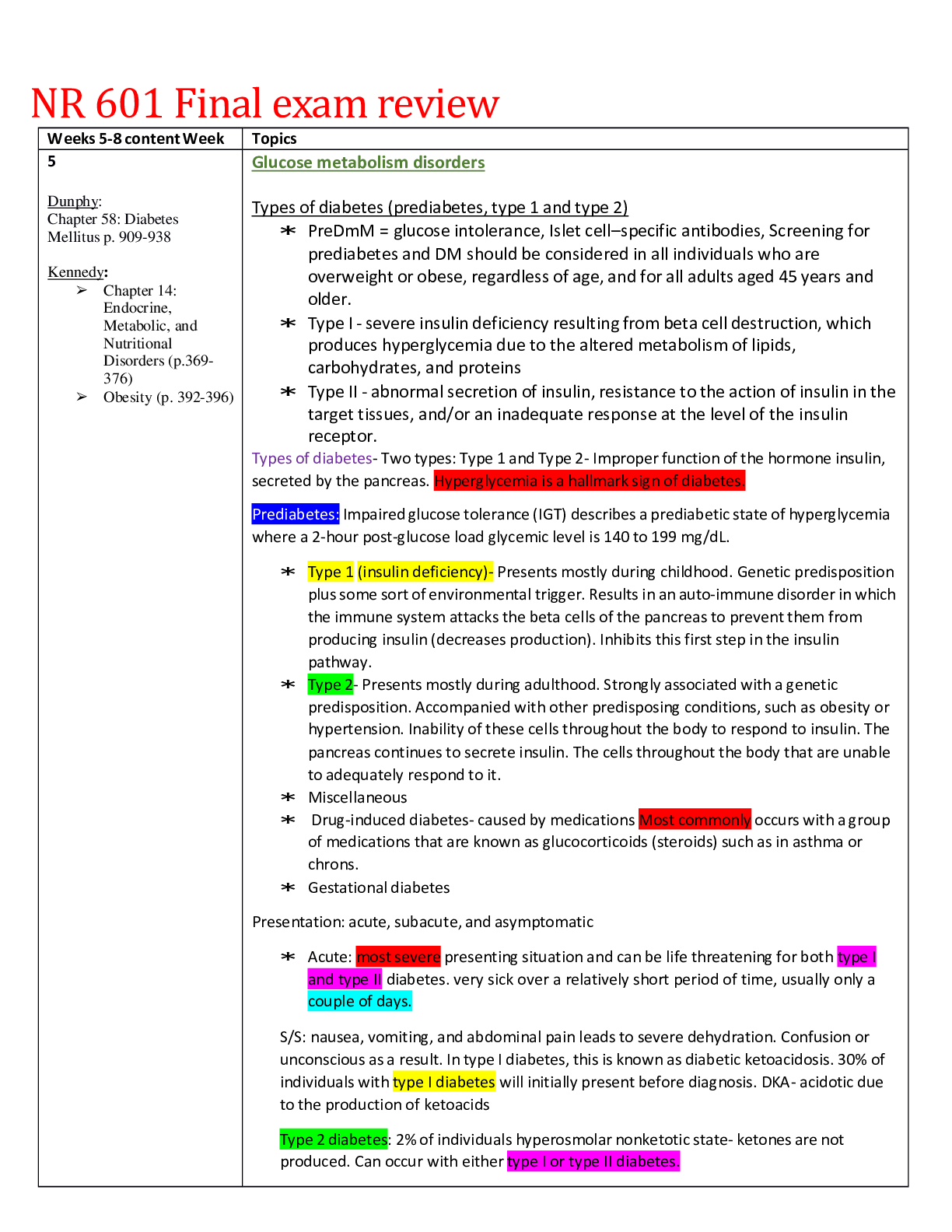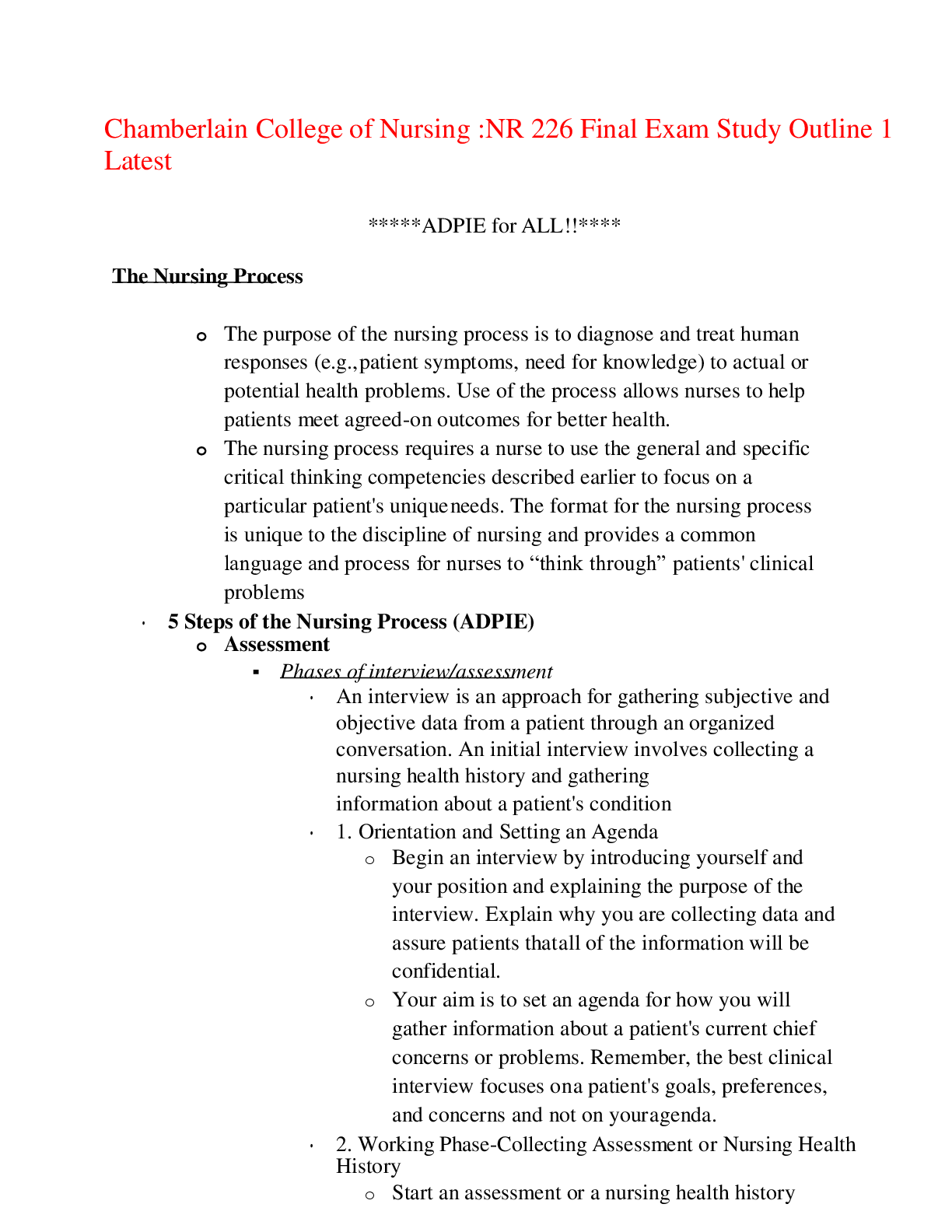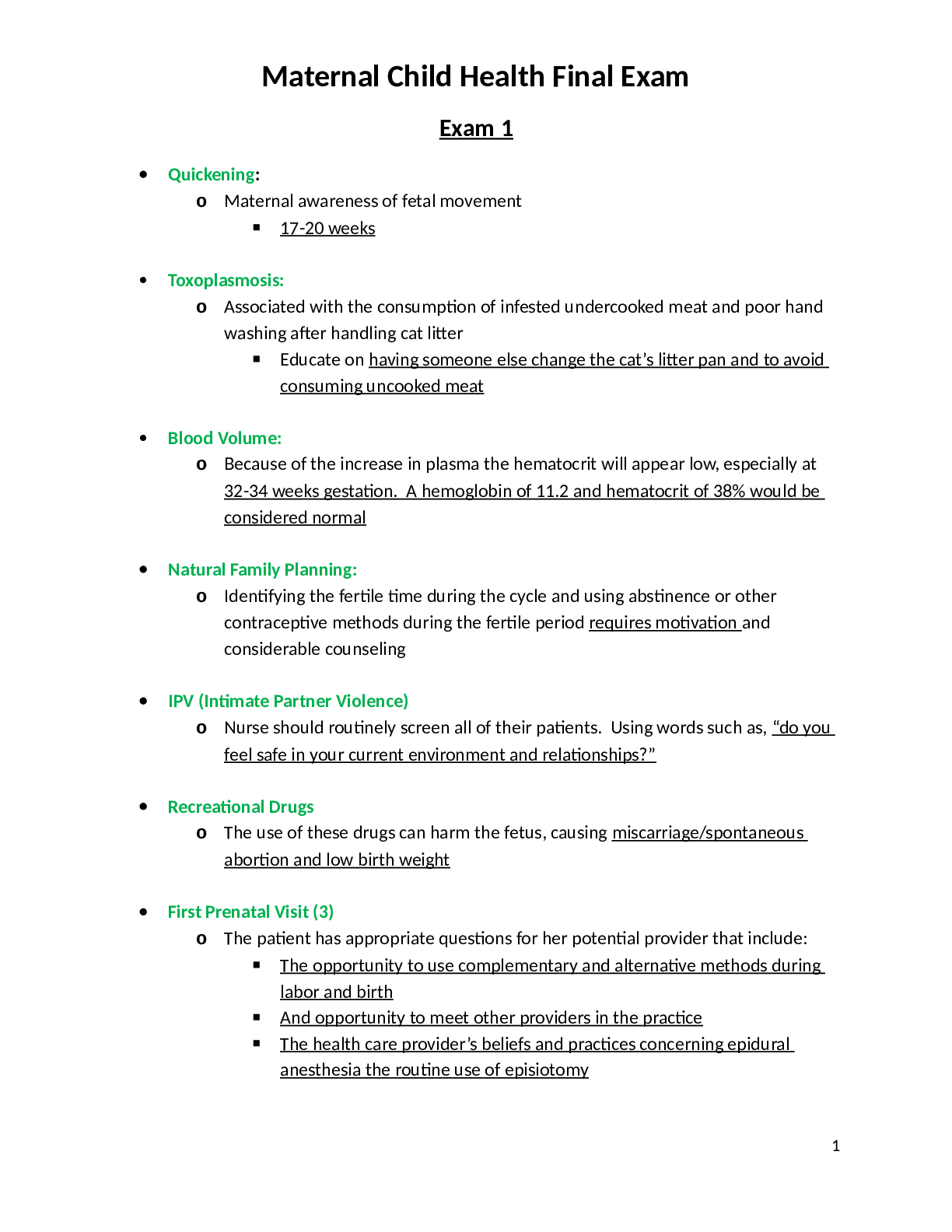*NURSING > Final Exam Review > NURS 307 Final Exam Review; West Coast University (All)
NURS 307 Final Exam Review; West Coast University
Document Content and Description Below
FINAL REVIEW (40:39 on BB Collab) 1. Treatment for Pulmonary Atresia Prostagladin E to keep PDA Treat symptoms of CHF Surgery 2. Where to give intramuscular injection Infants = ... vastus lateralis Peds = deltoid 3. Anatomy and physiology of infant’s heart 4. Childhood patent ductus arteriosus... What to find on assessment? dyspnea , tachycardia Full, bounding pulses Hypotension “Machine” murmur 5. Know what pertussis (Whooping Cough) is Patho: Pertussis is primarily a toxin-mediated disease. The bacteria attach to the cilia of the respiratory epithelial cells, produce toxins that paralyze the cilia, and cause inflammation of the respiratory tract, which interferes with the clearing of pulmonary secretions. s/s: Runny nose Low-grade fever (generally minimal throughout the course of the disease) Mild, occasional cough Apnea – a pause in breathing (in babies) Vaccine for it is → DTap 6. Kawasaki disease.... Know what they are likely to develop While the majority of heart disease in children is congenital (present at birth), it is possible for kids to develop heart disease later in childhood. Kawasaki disease is the leading cause of acquired heart disease in kids. Acute: Irritability high fever lasting 5 or more days red throat Subacute: afebrile, cracking lips and fissures, desquamation of skin on tips of toes and fingers, 7. Know how to treat Rheumatic fever Antibiotics Aspirin Prophylactic antibiotics for invasive procedure and dental work 8. Know what successive vaccinations are releasing antibody antigen response ?? 9. Know the evaluation of the infants that are septic Infants under 2 months → Any fever in an infant under 1-2 months needs to be evaluated for neonatal sepsis At risk for neonatal sepsis Workup → LP , Blood & urine cultures, IV antibiotics ASAP & monitoring 10. Atrial septic defect.. what kind of shunt is it? LEFT to RIGHT shunting of blood 11. know different disorders that fall under the umbrella of cyanotic disease Pulmonary Atresia Tricuspid Atresia Tetralogy of Fallot 12. therapeutic regimen for patient with heart failure will be Maintain fluid and electrolyte balance Decrease workload of the heart Provide adequate nutrition Increase tissue oxygenation -- not sure? maybe? Meds: diuretics, ACE inhibitors 13. client education for sickle cell disease Often at an early age this child becomes opioid tolerant Seizure precaution 14. parenteral education for patient with hemophilia (Things they need to avoid) AVOID BLEEDING EPISODES 15. Foods they need to take for iron deficiency anemia Foods high in iron such as Shellfish Spinach Live and other organ meats Legumes (beans, lentils, chickpeas, peas, soybeans) Red meat Pumpkin seeds 16. Long term complications of thalassemia major Severe anemia? 17. If child has ITP and given steroids what do you need to monitor for? PLATELETS Monitor for Infection and hyperglycemia 18. Aplastic Anemia know pathophysiology Patho: Failure of bone marrow to produce blood cells resulting in pancytopenia Develops after treatment with radiation, medications, infections or congenital in nature. 19. Know what STAGE 2 WILMS TUMOR MEANS Patho: Intrarenal tumor that grows rapidly (doubling in size approx 11-13 days Manifestations: Firm, lobated mass on one side or midline of abdomen If symptomatic: HTN, abdominal pain and or hematuria Management: Nephrectomy of affected tumor Chemo and/or radiation Don’t palpate mass aggressively Stage II: (graph in textbook) -tumor extends beyond the kidney and is completely excised -regional extension of the tumor is presented -vessels outside the kidney are infiltrated or contain tumor thrombus 20. Lymphatic Leukemia Patho: Stem cells in the bone marrow produce immature WBCs that do not function normally and are produced at a rapid rate that replaces the normal functioning cells leaving the body at an increased risk for infection. Acute lymphatic leukemia- affects lymphocytes predominantly Manifestation: Petechiae Ecchymosis Abnormal bleeding Fever Splenomegaly Diagnosis: initially made by abnormal CBC (anemia, thrombocytopenia and/or neutropenia Confirmed by bone marrow aspiration 21. Comfort Care 22. know what to do diagnosis with terminal illness... what type of treatments are available for that scenario 23. know what to do for immunodeficiency syndrome for HIV Patho: HIV destroys the T cells in the body leaving the immune system weakened and allows for opportunistics infections Management: Preventions of transmission Prevent opportunistic infections 24. Child with AIDS.. as a nurse you would use to ENCOURAGE EFFECTIVE LUNG EXPANSION. (PROF WILL CHANGE QUESTION) 25. know the activities that children with juvenile rheumatoid arthritis can do.. and most appropriate thing for them to do They need extra time completing ADLs 26. Know what is caused by histamine release. KNOW (ALLERGIC REACTION) Patho: Antigen-antibody reaction to an allergen Can manigest as anaphylaxis, atopic dermatitis, contact dermatitis, serum sickness Allergen binds to antibodies on mast cells → Histamine is released from the mast cell → an allergic reaction ensues 27. FIRST priority for anaphylatic shock AIRWAAAAAY! ABC’S ALSO, Avoidance of allergen 28. Know what to do for anaphylactic shock Avoidance of allergen ABC’s Epinephrine, IV, or IM 29. Pathophysiology for anaphylactic reactions Patho: Anaphylaxis is a severe, systemic hypersensitivity reaction that is rapid in onset and characterized by life-threatening airway, breathing, and/or circulatory problems, and that is usually associated with skin and mucosal changes. 30. Know histamine response (STUDY PICTURE ON SLIDE) Sensitization: Initial exposure to allergen Allergen (ie: pollen, grain) enters into the bloodstream → B cells differentiate into plasma cells and make antibodies → antibodies attach to mast cells Allergic Reaction: Secondary exposure to same allergen Allergen binds to antibodies on mast cells → Histamine is released from the mast cell → an allergic reaction ensues 31. Brain Tumor (SELECT ALL THAT APPLY) 4 things on brain tumor (4 SYMPTOMS) Manifestations: Behavioral and nervous system changes Increased ICP (rapid or slowly) o Headache o Nausea o Vomiting o Abnormal gait o Dizziness o Vision changes o Fatigue +mental status changes or educational problems Treatment: Surgery Chemotherapy and/or radiation 32. Non-Hodgkins lymphoma that nurse is at high risk for kidney or renal disorders tenks 8===D~~ SMH *He said to focus on the difference between these two. Hodgkin NON-Hodgkin Patho: starts in a single lymph node or chain Large cell with multiple nuclei Patho: T-cell abnormalities that cause immature, malignant and diffuse T-cells Often occurs in children with congenital or acquired immunodeficiency, autoimmune diseases. s/s Nontender, firm lymphadenopathy May cause resp. Symptoms if pressure is placed on trachea or bronchi If progressed → fever, night sweats, and weight loss s/s Fever Weight loss Enlarged or nodular lymph nodes may or may not be present o May cause resp. Compromise if trachea/bronchi has pressure Pain and swelling in lymph nodes Swelling of face Enlargement of lymph nodes: o Neck o Armpits o Groin RESP: o SOB o Chest pain o Difficulty breathing o Coughs Abdominal pain, distention, bloating and constipation Loss of appetite, diarrhea, weight loss Management Chemotherapy and/or radiation High survival rate Managementdisease Chemotherapy and/or radiation Hematopoietic stem cell transplant for recurrent disease 33. Diagnosis of acute lymphatic leukemia know diagnosis for this one (PATHO) PATHO: Stem cells in the bone marrow produce immature WBCs that do not function normally and are produced at a rapid rate that replaces the normal functioning cells leaving the body at an increased risk for infection ***ALL (acute lymphocytic leukemia) – affects lymphocytes predominantly*** DX: Initially made by abnormal CBC (anemia, thrombocytopenia and/or neutropenia) Confirmed by bone marrow aspiration 34. Hodgkins disease patient with hodgkins.. know expected findings Nontender, firm lymphadenopathy Respiratory difficulty Fever Night sweats, weight loss 35. neuroblastoma study manifestations.. they will have an ELEVATION IN WHAT?????? Tumor markers: Homovanillic acid (HVA) and vanillylmandelic acid (VMA) are by- products of adrenal hormones are usually elevated in the urine and blood -Elevation in dopamine, ferritin, NSE, LDH, and GD2 Manifestations: Dependent on the location of the mass, but problems are caused by pressure onto organs Weight loss Abdominal distension Irritability, fatigue, fever Elevation in whaaaaat??? 36. Sickle Cell Disease know what it does to the tissue how it causes pain Obstruct capillary blood flow → tissue ischemia/hypoxia → organ tissues become damaged and impaired function pain results from avascular necrosis of the bone marrow 37. Lupas.. Know the highest priority nursing diagnosis PAIN? Body Image? Patho: Autoantibodies are produced and immune complexed form and are deporisted into connective tissue, triggering and inflammatory response which overtime damages the connective tissue. Can affect all organs, but small blood vessels, glomeruli, joings, spleen and heart valves most common [Show More]
Last updated: 2 years ago
Preview 1 out of 17 pages

Buy this document to get the full access instantly
Instant Download Access after purchase
Buy NowInstant download
We Accept:

Reviews( 0 )
$13.00
Can't find what you want? Try our AI powered Search
Document information
Connected school, study & course
About the document
Uploaded On
Mar 30, 2022
Number of pages
17
Written in
Additional information
This document has been written for:
Uploaded
Mar 30, 2022
Downloads
0
Views
134












_removed.png)



